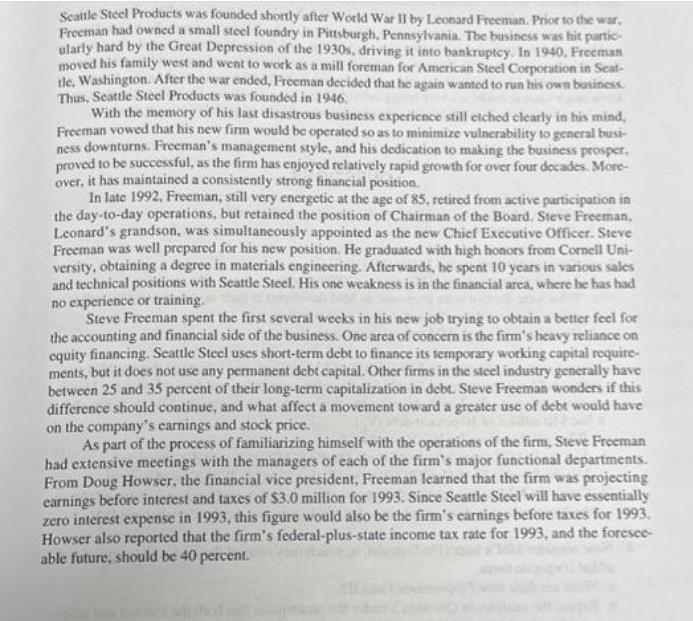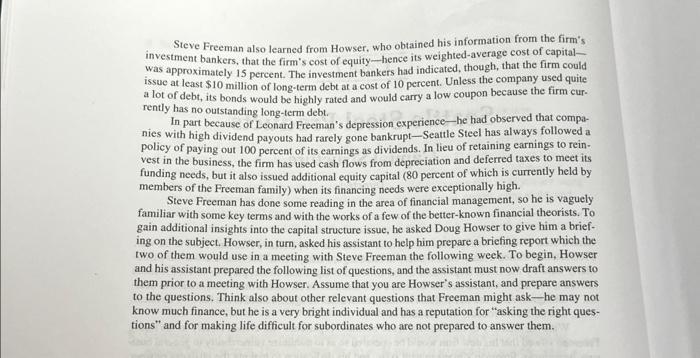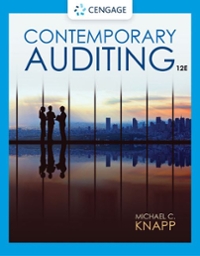Answered step by step
Verified Expert Solution
Question
1 Approved Answer
Seattle Steel Products was founded shortly after World War II by Leonard Freeman. Prior to the war. Freeman had owned a small steel foundry



Seattle Steel Products was founded shortly after World War II by Leonard Freeman. Prior to the war. Freeman had owned a small steel foundry in Pittsburgh, Pennsylvania. The business was hit partic- ularly hard by the Great Depression of the 1930s, driving it into bankruptcy. In 1940, Freeman moved his family west and went to work as a mill foreman for American Steel Corporation in Seat- tle, Washington. After the war ended, Freeman decided that he again wanted to run his own business. Thus, Seattle Steel Products was founded in 1946. With the memory of his last disastrous business experience still etched clearly in his mind, Freeman vowed that his new firm would be operated so as to minimize vulnerability to general busi- ness downturns. Freeman's management style, and his dedication to making the business prosper. proved to be successful, as the firm has enjoyed relatively rapid growth for over four decades. More- over, it has maintained a consistently strong financial position. In late 1992, Freeman, still very energetic at the age of 85, retired from active participation in the day-to-day operations, but retained the position of Chairman of the Board. Steve Freeman, Leonard's grandson, was simultaneously appointed as the new Chief Executive Officer. Steve Freeman was well prepared for his new position. He graduated with high honors from Cornell Uni- versity, obtaining a degree in materials engineering. Afterwards, he spent 10 years in various sales and technical positions with Seattle Steel. His one weakness is in the financial area, where he has had no experience or training. Steve Freeman spent the first several weeks in his new job trying to obtain a better feel for the accounting and financial side of the business. One area of concern is the firm's heavy reliance on equity financing. Seattle Steel uses short-term debt to finance its temporary working capital require- ments, but it does not use any permanent debt capital. Other firms in the steel industry generally have between 25 and 35 percent of their long-term capitalization in debt. Steve Freeman wonders if this difference should continue, and what affect a movement toward a greater use of debt would have on the company's earnings and stock price. As part of the process of familiarizing himself with the operations of the firm, Steve Freeman had extensive meetings with the managers of each of the firm's major functional departments. From Doug Howser, the financial vice president, Freeman learned that the firm was projecting earnings before interest and taxes of $3.0 million for 1993. Since Seattle Steel will have essentially zero interest expense in 1993, this figure would also be the firm's earnings before taxes for 1993. Howser also reported that the firm's federal-plus-state income tax rate for 1993, and the foresee- able future, should be 40 percent. Steve Freeman also learned from Howser, who obtained his information from the firm's investment bankers, that the firm's cost of equity--hence its weighted-average cost of capital- was approximately 15 percent. The investment bankers had indicated, though, that the firm could issue at least $10 million of long-term debt at a cost of 10 percent. Unless the company used quite a lot of debt, its bonds would be highly rated and would carry a low coupon because the firm cur- rently has no outstanding long-term debt. In part because of Leonard Freeman's depression experience he had observed that compa- nies with high dividend payouts had rarely gone bankrupt-Seattle Steel has always followed a policy of paying out 100 percent of its earnings as dividends. In lieu of retaining earnings to rein- vest in the business, the firm has used cash flows from depreciation and deferred taxes to meet its funding needs, but it also issued additional equity capital (80 percent of which is currently held by members of the Freeman family) when its financing needs were exceptionally high. Steve Freeman has done some reading in the area of financial management, so he is vaguely familiar with some key terms and with the works of a few of the better-known financial theorists. To gain additional insights into the capital structure issue, he asked Doug Howser to give him a brief- ing on the subject. Howser, in turn, asked his assistant to help him prepare a briefing report which the two of them would use in a meeting with Steve Freeman the following week. To begin, Howser and his assistant prepared the following list of questions, and the assistant must now draft answers to them prior to a meeting with Howser. Assume that you are Howser's assistant, and prepare answers to the questions. Think also about other relevant questions that Freeman might ask-he may not know much finance, but he is a very bright individual and has a reputation for "asking the right ques- tions" and for making life difficult for subordinates who are not prepared to answer them. Now prepare a summary of the implications of capital structure theory which can be pre- sented to Steve Freeman. Consider specifically these issues: (a) Are the tax tradeoff and asymmetric information theories mutually exclusive? (b) Can capital structure theory be used to actually establish a firm's optimal capital structures with precision? If not, then what insights can capital structure theory provide managers regarding the factors which influence their firms' optimal capital structures?
Step by Step Solution
★★★★★
3.36 Rating (146 Votes )
There are 3 Steps involved in it
Step: 1
What is capital structure and why is it important for a firm like Seattle Steel Capital structure refers to the mix of debt and equity financing a company uses to operate and expand its business Its c...
Get Instant Access to Expert-Tailored Solutions
See step-by-step solutions with expert insights and AI powered tools for academic success
Step: 2

Step: 3

Ace Your Homework with AI
Get the answers you need in no time with our AI-driven, step-by-step assistance
Get Started


